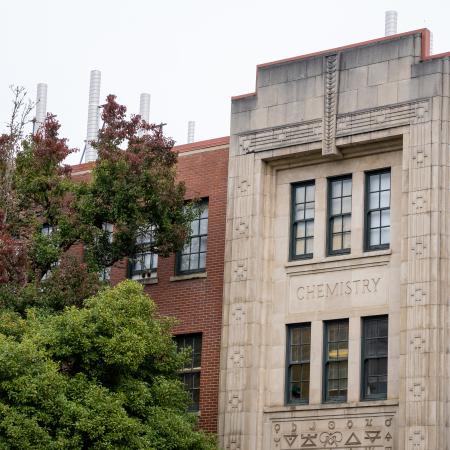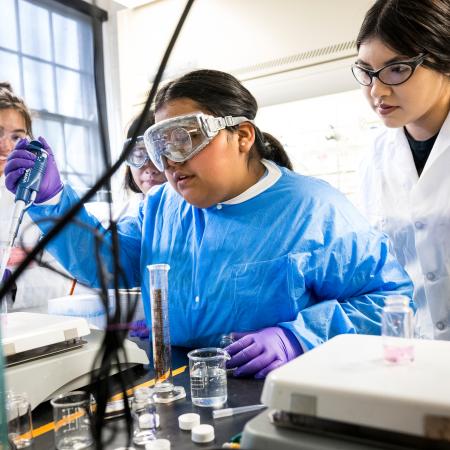This page is intended primarily for transfer students from Oregon community colleges who wish to major in chemistry at Oregon State University. However, much of this information can serve as a guide for transfer students from other 4-year colleges, universities or community colleges in other states. In general, you should look at the other pages on this Advising home page that contain information about the chemistry curriculum.
Basic coursework
If you are planning to transfer to OSU and wish to obtain your degree in the minimum possible time, you should try to complete, where possible, the course work that a chemistry student at OSU would have taken in the first two years. This includes:
- A year of general chemistry with lab
- A year of organic chemistry with lab
- At least 3 terms of calculus (including differential, integral and multivariable)
- A year of physics with lab
Additionally you should take courses that fulfill the Baccalaureate Core requirements at OSU (skills and perspective courses). The most common reason that transfer students are behind in course work compared to "equivalent" chemistry majors at OSU is the lack of calculus.
Typical major courses
A typical chemistry major at OSU pursuing a B.S. or B.A. in chemistry would take at a minimum, the following chemistry, math and physics courses the first two years at OSU.
Year one
Fall
- CH 231/261 - General Chemistry
- MTH 112 - Elementary Functions
Winter
- CH 232/262 - General Chemistry
- MTH 251 - Differential Calculus
Spring
- CH 233/263 - General Chemistry
- MTH 252 - Integral Calculus
Year two
Fall
- CH 334 - Organic Chemistry and CH 361 - Experimental Chemistry I
- PH 211 & 221 - General Physics with Calculus and Recitation or PH 201 - General Physics
- MTH 254 - Vector Calculus I
Winter
- CH 335 - Organic Chemistry and CH 362 - Experimental Chemistry I
- PH 212 & 222 - General Physics with Calculus and Recitation or PH 202 - General Physics
Spring
- CH 336 - Organic Chemistry
- PH 213 & 223 - General Physics with Calculus and Recitation or PH 203 - General Physics
There are 10 options possible with the B.S. degree, and the required coursework for the first two years varies slightly for each option in terms of the number of math courses and the level of physics required. For example, for many options, only MTH 251, 252, and MTH 254 are required and the physics sequence, PH 201-203 is allowed (see the specific curricula for the options). For options such as advanced chemistry, advanced biochemistry, chemical engineering, and materials science, the PH 221-223 sequence is required as well as MTH 256 and MTH 253 in some cases.
In general, the courses numbers for general chemistry, mathematics, and physics are the same at both OSU and Oregon community colleges.
The organic chemistry sequence at OSU is somewhat unique. It includes three 3-credit lecture courses (CH 334-336) and two 3-credit laboratory courses (CH 361-362). The laboratory courses are the first two terms of a 6-term experimental chemistry laboratory sequence and the emphasis is on organic chemistry although other types of chemistry are included in the courses. In general, the organic chemistry sequence at community colleges is based on three courses (usually CH 241, 242, 243) with both a lecture and laboratory component and is not equivalent to OSU courses. For a student who has taken and performed adequately in a complete community college organic chemistry sequence, we generally waive the requirement that the student take CH 334-336 and CH 361 at OSU, but the student must still take CH 362. The judgment about what courses a student must take is made on a case-by-case basis when you meet with your chemistry advisor at START.
Note that when organic chemistry courses from Oregon community colleges (CH 241, 242, 243) are transferred to OSU, the student normally receives lower division credit. The course work may appear on the transcript as various combinations of CH 331, CH 332, CH 337, and unspecified lower division transfer credit. A student may receive upper division credit (300 level) if they perform at an adequate level on the American Chemical Society organic chemistry exam.
A transfer student who has followed the path described above and has accumulated about 90 transferrable credits can often graduate in 6 to 7 terms at OSU. The student must also complete all other chemistry career supportive electives, College of Science and university requirements.
Sample academic plan for B.S. degree
A possible program for the ACS-certified B.S. degree with an advanced chemistry option is shown below (assumes the student has completed the transfer courses listed above):
Transfer year one at OSU
Fall
- CH 440 - Physical Chemistry
- CH 421 - Analytical Chemistry
- CH 461 - Experimental Chemistry II
Winter
- CH 441 - Physical Chemistry
- CH 422 - Analytical Chemistry
- CH 462 - Experimental Chemistry II
Spring
- CH 442 - Physical Chemistry
- CH 463 - Experimental Chemistry II
Transfer year two at OSU
Fall
- CH 411 - Inorganic Chemistry
- CH 464 - Experimental Chemistry II
- BB 490 - Biochemistry 1: Structure and Function
Winter
- CH 412 - Inorganic Chemistry
- BB 491 - Biochemistry 2: Metabolism
Required courses will vary considerably depending on the particular option chosen. All chemistry students are required to take all courses listed above in bold. The specific courses required for ALL chemistry tracks and degrees are the following:
- One year of physical chemistry (CH 440-442)
- One or two terms of inorganic chemistry (CH 411 and/or CH 412)
- One or two terms of analytical chemistry (CH 421 & 422 or CH 324)
- One or more advanced chemistry laboratory courses (CH 461-CH 464)
- At least one Writing Intensive Course (WIC) (CH 462 or CH 463 or CH 464 for chemistry courses)
- See the specific curricula for the differences in the options offered.
Other courses for specific options or B.A.
For some options, it can be advantageous to take some other courses during the first or second year that are required for the option or prerequisites for other courses. Here are a few suggestions. Many but not all of these courses can be taken at a community college.
Advanced Biochemistry
- Possible first year options: BI 22X
- Possible second year options: MTH 253, BB 314 (recommended elective)
Advanced Chemistry
- Possible second year options: MTH 253, MTH 256
Business
Possible first year options: ECON 201
- Possible second year options: BA 315, BA 230 or 347, CH 324
Chemistry Education
- Possible second year options: CH 324
Chemical Engineering
- Possible second year options: MTH 256
Biochemistry, Environmental Chemistry, Forensic Science, Pre-Medicine
- Possible first year options: BI 22X
- Possible second year options: BI 314
Materials Science
- Possible second year options: MTH 256
Bachelors of Arts Degree
- Possible first year options: Language course
- Possible second year options: Language course
a BI 22X is an enforced pre-requisite for BB 314



